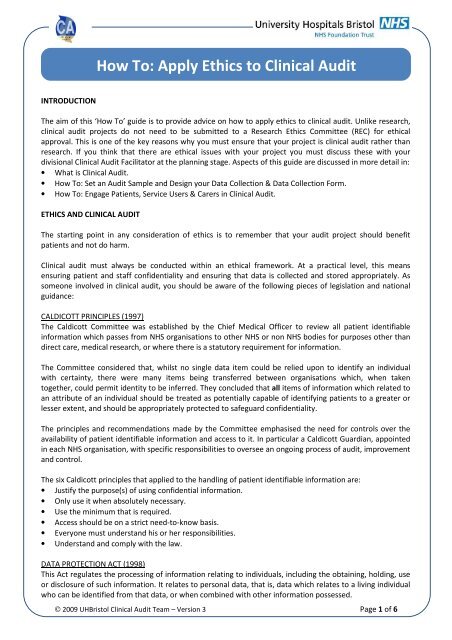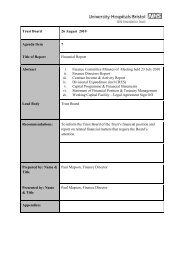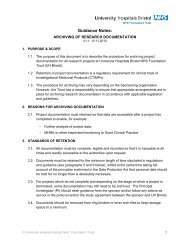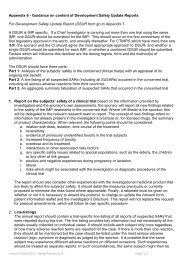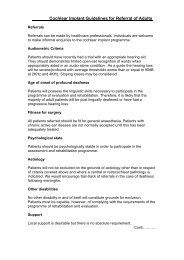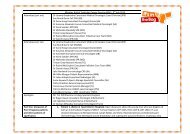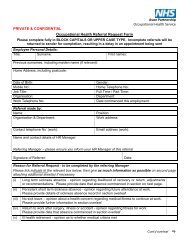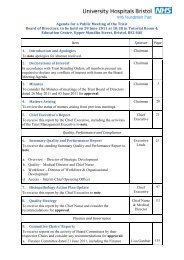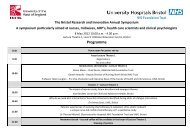Apply Ethics to Clinical Audit - United Bristol Healthcare NHS Trust
Apply Ethics to Clinical Audit - United Bristol Healthcare NHS Trust
Apply Ethics to Clinical Audit - United Bristol Healthcare NHS Trust
- No tags were found...
Create successful ePaper yourself
Turn your PDF publications into a flip-book with our unique Google optimized e-Paper software.
How To: <strong>Apply</strong> <strong>Ethics</strong> <strong>to</strong> <strong>Clinical</strong> Audi<strong>to</strong>n the data collection form. Therefore the best approach is <strong>to</strong> number each of your forms using aunique identifier. A separate piece of paper, or ‘code sheet' should then be kept as a key, which linkseach unique identifier <strong>to</strong> the patients hospital number. Without this list, data collection forms cannot belinked <strong>to</strong> specific patients. The key would need <strong>to</strong> be destroyed when the audit analysis is complete. Thisalso applies <strong>to</strong> data held on databases. Occasionally it might be necessary <strong>to</strong> record patient identifiableinformation on the data collection form. For example during a prospective data collection exercise thedata collection form might have <strong>to</strong> follow a patient through their pathway of care. In this instance theonly patient identifiable information that should be recorded on the form is their hospital ID number.Name, date of birth, etc should never be recorded.• Adequate, relevant and not excessive. Ensure data is being collected for the stated purpose of clinicalaudit rather than research or other service improvement activities and collect only the data you need <strong>to</strong>answer your audit objectives and standards, bearing in mind the ‘adequate, relevant and not excessive’Data Protection Act principle.• Data should be kept securely - This relates <strong>to</strong> both electronic and hard copies of data. Any patientidentifiable clinical audit data must be kept securely. <strong>Audit</strong> proformas should be locked in a filingcabinet, electronic files should be password protected or kept on a secure, restricted access server andensuring that only clinical professionals with a duty of confidentiality are able <strong>to</strong> access the data. Personidentifiable information should not be s<strong>to</strong>red on personal lap<strong>to</strong>p computers or e-mailed <strong>to</strong> non <strong>NHS</strong> e-mail accounts. Data can only be e-mailed <strong>to</strong> UHBris<strong>to</strong>l e-mail addresses or <strong>NHS</strong>.net. Situations should beavoided that might allow public access <strong>to</strong> personal data, such as leaving patient files in the boot of yourcar. Your car could be s<strong>to</strong>len with the files in it.• Data should not be kept for any longer than necessary - Remember <strong>to</strong> destroy completed auditproformas once an audit has been completed. Double-check with other members of the audit team firstthough and make sure you have kept enough summarised data <strong>to</strong> allow comparison with any re-auditdata you may collect in future.CLINICAL STAFF CONFIDENTIALITYIt is also important <strong>to</strong> remember that clinical audit reports and presentations should not identify cliniciansby name unless the people concerned have agreed <strong>to</strong> this.DO YOU NEED ETHICS APPROVAL FOR AUDIT?Whilst research needs <strong>to</strong> be submitted <strong>to</strong> REC for ethical approval, clinical audit does not. However, whilstclinical audit by definition does not involve anything being done <strong>to</strong> patients beyond their routine clinicalmanagement and therefore does not require formal ethical approval, it should still be conducted within anethical framework. By approving and registering a project as a clinical audit, the <strong>Trust</strong> is stating that theproject fulfils the methodological criteria that allows for patient data <strong>to</strong> be accessed and analysed.However, before assuming that you do not require ethical approval, it is important <strong>to</strong> consider:1. IS YOUR PROJECT REALLY A CLINICAL AUDIT PROJECT?Decisions about whether projects need ethical approval often hinge on the question of whether they reallyare clinical audit, or whether they are actually research. Remember that clinical audit asks the questions“are we following best practice?” and “what is happening <strong>to</strong> patients as a result?”<strong>Clinical</strong> audit projects never involve:• A completely new treatment or practice.• The use of control groups or placebo treatments.• Any disturbance <strong>to</strong> the patient beyond that required for routine clinical management.• Allocating patients randomly <strong>to</strong> different treatment groups.<strong>Clinical</strong> audit may, however, involve input from patients at a number of levels, e.g.© 2009 UHBris<strong>to</strong>l <strong>Clinical</strong> <strong>Audit</strong> Team – Version 3 Page 3 of 6
How To: <strong>Apply</strong> <strong>Ethics</strong> <strong>to</strong> <strong>Clinical</strong> <strong>Audit</strong>• Patients may be asked <strong>to</strong> participate in surveys which help <strong>to</strong> determine whether standards have beenmet.• Patients may be involved in the design of individual audit projects or indeed whole programmes ofactivity, e.g. as members of steering groups.Sometimes healthcare professionals undertake what they mistakenly think is ‘clinical audit’, when what theyare really doing is research. Research always requires ethical approval. Calling research by any other namedoes not remove this requirement.If you are unsure whether or not the project that you want <strong>to</strong> undertake is clinical audit or research yourdivisional <strong>Clinical</strong> <strong>Audit</strong> Facilita<strong>to</strong>r will be able <strong>to</strong> advise. Very occasionally liaison might be required betweenyour divisional <strong>Clinical</strong> <strong>Audit</strong> Facilita<strong>to</strong>r, the Research & Effectiveness Department and the local REC. If theconclusion is that you are undertaking research, you must formally submit the appropriate paperwork <strong>to</strong> thelocal REC for ethics approval.If on the other hand your project contains an element of both clinical audit and research, you will need <strong>to</strong>obtain formal ethical approval for the research component of the project from REC and submit a completedcopy of the clinical audit proposal form <strong>to</strong> your divisional <strong>Clinical</strong> <strong>Audit</strong> Facilita<strong>to</strong>r for the clinical auditcomponent.2. DOES YOUR PROJECT INCLUDE A PATIENT SURVEY?Patient surveys can be construed as doing something <strong>to</strong> patients ‘beyond normal clinical management’. It istherefore important <strong>to</strong> take advice on the design of patient surveys. Planned questions could <strong>to</strong>uch uponpotentially sensitive matters, giving rise <strong>to</strong> ethical concerns. Any patient surveys should be designed in sucha manner as <strong>to</strong> cause minimum possible disruption <strong>to</strong> patients.All structured surveys, staff or patient, administered by post, in hospital, or via a one-<strong>to</strong>-one interview,undertaken for clinical audit are subject <strong>to</strong> approval by the Questionnaire, Interview and Survey (QIS) Group.The contact details for the QIS group are listed at the end of this guide. The QIS group offers advice onsurvey design and is responsible for moni<strong>to</strong>ring all survey activity at the <strong>Trust</strong>. Please contact Paul Lewis, thePatient Involvement Facilita<strong>to</strong>r for advice on structured surveys/ questionnaires. If you require advice onunstructured interviews and focus groups, this should be discussed with Tony Watkin, the <strong>Trust</strong>’s PublicInvolvement Project Lead. The contact details for Paul Lewis and Tony Watkin are listed at the end of thisguide.Formal Research projects are subject <strong>to</strong> ethical approval by the local REC and therefore do not require QISapproval.When undertaking a survey it is important <strong>to</strong> consider the patient's, service users or carers rights, dignityand time. Should you wish <strong>to</strong> undertake a survey as part of your clinical audit project there are a number ofethical questions that you should consider. These are:• Is the information that you are seeking already available? The QIS group may not approve projects if itfeels that one group of patients is being excessively targeted.• Is it necessary <strong>to</strong> carry out a survey? Surveys should only ask for information that cannot be collectedfrom another source and that is related <strong>to</strong> processes or the outcome of care, i.e. were standards of bestpractice being met.• Will it add value <strong>to</strong> the clinical audit project? Carrying out a survey unnecessarily, or asking morequestions than necessary, will not add value <strong>to</strong> your project. Keep your questionnaire succinct. It isimportant not <strong>to</strong> bombard patients with <strong>to</strong>o many questions as they might choose not <strong>to</strong> participate ifthe questionnaire looks <strong>to</strong>o long; up <strong>to</strong> 20 questions is usually sufficient.• Have you checked your sample? Your sample, if postal survey, should be checked against the latesthospital records, as sending questionnaires <strong>to</strong> deceased patients is a frequent error that can cause© 2009 UHBris<strong>to</strong>l <strong>Clinical</strong> <strong>Audit</strong> Team – Version 3 Page 4 of 6
How To: <strong>Apply</strong> <strong>Ethics</strong> <strong>to</strong> <strong>Clinical</strong> <strong>Audit</strong>distress <strong>to</strong> relatives. Similarly, getting patients’ names or other details slightly wrong can also causeoffence.• What written information will be given <strong>to</strong> the subject <strong>to</strong> explain what the survey is about? Include acovering letter with all patient questionnaires. A template covering letter is available on the QIS intranetsite. The intranet details are listed at the end of this guide. The letter should include contact detailsshould the patient have any queries that they wish <strong>to</strong> be answered quickly about the questionnaire, thebackground <strong>to</strong> project and reason for contacting the patients, instructions on how <strong>to</strong> return thecompleted questionnaire, a statement on how you will protect the patient’s confidentiality, ideally thisshould be achieved through developing completely anonymised questionnaires, and what you intend <strong>to</strong>do with the data collected.• How will you ensure that patients freely consent <strong>to</strong> taking part? Patients must not be coerced in<strong>to</strong>taking part and must have the option <strong>to</strong> decline or withdraw without detriment or antagonism.• Is your survey addressing a sensitive <strong>to</strong>pic? Where patients are being asked questions about their clinicalcare, it is important that questions are not phrased inappropriately/insensitively, as this mightinadvertently cause harm.• Will the survey interfere with the treatment of the patient? Your survey should not cause the patient <strong>to</strong>reflect negatively upon their course of treatment, thereby jeopardising clinical outcomes.If you are in any doubt about whether your survey raises ethical concerns please discuss with your divisional<strong>Clinical</strong> <strong>Audit</strong> Facilita<strong>to</strong>r.3. ARE YOU PLANNING TO PUBLISH?<strong>Clinical</strong> <strong>Audit</strong>s are usually published because the <strong>to</strong>pic and/or methodology may be of interest <strong>to</strong> a wideraudience, for instance, demonstrating how an audit cycle was successfully followed after initially poorresults against standards, by implementing changes and demonstrating an improvement in practice with are-audit.Whilst clinical audit projects may be published without ethical approval, e.g. the Quality ImprovementReports published by the British Medical Journal, journal edi<strong>to</strong>rs may refuse <strong>to</strong> publish articles if there areethical concerns and REC ethical approval has not been granted. If you want <strong>to</strong> publish because of theresults of your project, rather than <strong>to</strong> share the methodology, you should question whether you areundertaking a research activity, rather than a clinical audit project, that should have been submitted <strong>to</strong> RECfor ethical approval. If you intend <strong>to</strong> publish your clinical audit project this should be discussed with your<strong>Clinical</strong> <strong>Audit</strong> Facilita<strong>to</strong>r at the beginning of your project.REFERENCES• Data Protection Act (1998) available [on-line]www.informationcommissioner.gov.uk/eventual.aspx?id=34• Caldicott Committee Report (1997) available [on-line]www.dh.gov.uk/assetRoot/04/06/84/04/04068404.pdf<strong>NHS</strong> Confidentiality Code of practice (2003) available [on-line]www.dh.gov.uk/assetRoot/04/06/92/54/04069254.pdfNote that figure 5 (p19) contains practical advice on keeping information secure, and figure 6 (p20)nicely summarises the relevant Caldicott principles.• Health & Social Care Act (2001), Section 60 available [on-line]www.legislation.hmso.gov.uk/acts/acts2001/10015--g.htm• “What we do with your personal information”, UHBris<strong>to</strong>l Patient Information leaflet, February 2008available [intranet]http://nww.avon.nhs.uk/dms/download.aspx?did=1655© 2009 UHBris<strong>to</strong>l <strong>Clinical</strong> <strong>Audit</strong> Team – Version 3 Page 5 of 6
How To: <strong>Apply</strong> <strong>Ethics</strong> <strong>to</strong> <strong>Clinical</strong> <strong>Audit</strong>CONTACT DETAILS/ USEFUL INFORMATIONCLINICAL AUDIT• The UHBris<strong>to</strong>l <strong>Clinical</strong> <strong>Audit</strong> website is available [online] via: http://www.uhbris<strong>to</strong>l.nhs.uk/healthcareprofessionals/clinical-audit.html• Contact details for the UHBris<strong>to</strong>l <strong>Clinical</strong> <strong>Audit</strong> Team are available from the <strong>Clinical</strong> <strong>Audit</strong> CentralOffice or [online] via: http://www.uhbris<strong>to</strong>l.nhs.uk/healthcare-professionals/clinicalaudit/contacts.html• The full range of UHBris<strong>to</strong>l ‘How To’ guides are available [online] via:http://www.uhbris<strong>to</strong>l.nhs.uk/healthcare-professionals/clinical-audit/how-<strong>to</strong>-guides.html• A copy of the UHBris<strong>to</strong>l Proposal Form, Presentation Template, Report Template, Summary Form,and Action Form are available [online] via: http://www.uhbris<strong>to</strong>l.nhs.uk/healthcareprofessionals/clinical-audit/doing-projects-at-ubht.html• The UHBris<strong>to</strong>l <strong>Clinical</strong> <strong>Audit</strong> Central Office can be contacted on tel. (0117) 342 3614 or e-mail:stuart.metcalfe@uhbris<strong>to</strong>l.nhs.uk• <strong>Clinical</strong> <strong>Audit</strong> Training Workshops can be booked through the <strong>Clinical</strong> <strong>Audit</strong> Central Office.CLINICAL EFFECTIVENESS• For advice on <strong>Clinical</strong> Effectiveness, including how <strong>to</strong> write guidelines, contact James Osborne, <strong>Clinical</strong>Effectiveness Co-ordina<strong>to</strong>r, tel. (0117) 928 3827 or e-mail: james.osbourne@uhbris<strong>to</strong>l.nhs.ukPATIENT ENGAGEMENT• For advice on Patient Involvement, including designing structured surveys and questionnairescontact Paul Lewis, Patient Involvement Facilita<strong>to</strong>r, tel. (0117) 928 3638 or e-mail:paul.lewis@UHBris<strong>to</strong>l.nhs.uk• For advice on Patient Involvement, including unstructured surveys and focus groups contact TonyWatkin, Public Involvement Lead, tel. (0117 928 3729 or e-mail: <strong>to</strong>ny.watkin@UHBris<strong>to</strong>l.nhs.uk• Surveys MUST be approved by the <strong>Trust</strong>'s Questionnaire, Interview and Survey (QIS) Group.Proposals should be submitted <strong>to</strong> Paul Lewis using the QIS proposal form. The proposal form isavailable [online] via http://www.uhbris<strong>to</strong>l.nhs.uk/healthcare-professionals/clinical-audit/doingprojects-at-ubht.html• A copy of the UHBris<strong>to</strong>l Covering Letter template is available [online] via the internal intranet sitehttp://connect/Governance/patientexperience/ppi/Pages/QISGroup.aspxRESEARCH• For advice on research projects contact the Research & Development Department, tel. (0117) 3420233 or e-mail: r&doffice@uhbris<strong>to</strong>l.nhs.ukLITERATURE REVIEWS• For advice on literature reviews contact the Learning Resource Centre, tel. 0117 342 0105 or e-mail:learningresources@UHBris<strong>to</strong>l.nhs.ukSAMPLE SIZES• The Sample Size Calcula<strong>to</strong>r is available [online] via: http://www.uhbris<strong>to</strong>l.nhs.uk/healthcareprofessionals/clinical-audit/how-<strong>to</strong>-guides.html© 2009 UHBris<strong>to</strong>l <strong>Clinical</strong> <strong>Audit</strong> Team – Version 3 Page 6 of 6


